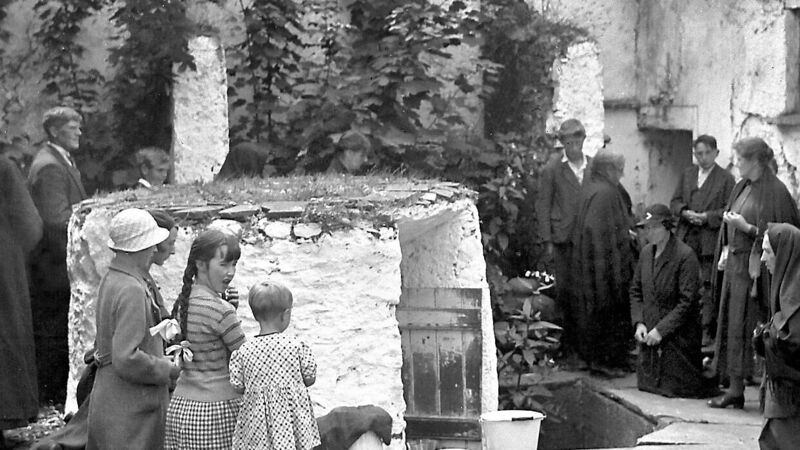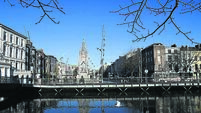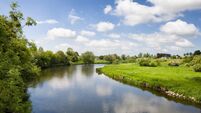A time capsule from 1912 that links past, present and future

Pilgrims pray at St Mary’s Holy Well in Killarney in 1925. John Arnold celebrated St Bartholomew’s Day at his local well this week.
History tells us he was martyred in Armenia — he was flayed and then beheaded. In paintings and depictions of the Saint, he is usually portrayed holding a butchers knife and is regarded as the Patron of Butchers.
Though the Holy Well on our farm is dedicated to the saint, we can be fairly certain that Bartholomew was never in Bartlemy — though the place is called after him. A bit like the close association we have with Napoleon Bonaparte, another character who probably never walked the roads or boreens around here, but his famous white steed Marengo was reputedly purchased at the Horse Fair here in the late 1700s.
We had Mass at the Well on Tuesday night just over the ditch from where the Fair was held in olden times.
Well, anyhow, our Parish Priest celebrated the open air Mass on Tuesday before a nice gathering scattered along the bank of the river Knoppogue.
It was a predecessor of our present pastor, Fr Edmond Barry, that engaged a mason, Garrett Heaphy, in the 1880s to build the stone enclosure around the Well.
Some unknown writer exiled far away from here penned a poem of nostalgia longing for home. One verse is as follows
Thoughts like those are to the fore in my mind on special days like St Bartholomew’s Day. Because the Well is on our farm, I suppose its care has been handed down from generation to generation of our family. We’re only in the place since the 1870’s and the Well might be a place of worship for a thousand years!
Was it a pagan well, ‘Christianized’ by some of St Patrick’s pals all those years ago? No more than the mystery of the Saint and the French Emperor, we’ll never know, but the traditions live on.
Talking and reminiscing meant that the dark was well down on us before we crossed the bridge over the river on Tuesday night. Two of my second cousins were there and we ended up ‘climbing and pruning’ our Family Tree!
My mother had only one first cousin on the Twomey side (her father’s side) and both women were named Mai and were some women for talking. Now, Mam’s first cousin my Grand Aunt Lizzie died the year I was born but, by all accounts, she could ‘trace’ for Ireland.
When her daughter Mai and my mam got together, well, there’s no doubt if there had been Olympic medals for conversation they’d have been Joint Winners of The Gold Medal!
I recall about 30 years ago a man named Paul Cotter and his daughters came to Ireland from the USA. They were trying to trace their Cotter ‘roots’ in this parish. We spent a night at mam’s first cousins home in Glenville trying to piece together the Cotter jigsaw.
What a night it was! There were ‘White’, ‘Black , ‘Bun’ and ‘Brown’ Cotter families in the area back in the 1800s when Paul’s great grandfather had emigrated, after the Famine.
Well, when the ‘two Mais’ got into full flight that night, there were Cotters everywhere. Both women were big into degrees of consanguinity, they knew the difference between a second cousin twice removed and a third cousin once removed!
Paul Cotter’s daughter had a tape recorder and many years later she sent me a ‘transcript’ of the night’s proceeding. What with ‘ Mai A said...’ and ‘Mai F said...’, it was a fairly complicated and convoluted piece of writing. In fairness, between them they sorted out the seed, breed and generation of the Cotters.
Ah yes, those evocative words of Thomas Moore do indeed recall the days of yore and as we lingered the other night by the old rustic bridge over the Knoppogue, we spoke of the future, the present and the past.
Just a century ago, my great, grandfather (same relation of my two cousins) died. That was in the turbulent year of 1921, the year of the Truce.
He had had a turbulent life himself. An advocate of tenant farmers rights, he got evicted from his farm in 1890 and spent a dozen years out of it. Ten years after he got his land back, he built a new house on the farm to replace the old thatched dwelling. Before the slate roof went on, he inserted a kind of ‘time capsule’ under the wall-plate.
My great grandfather had traced his lineage back to his own grandfather. He gave a full account of the Eviction and how he had to fight hard to get his farm back. He outlined the problems he had to surmount — it’s a really amazing legacy to have left. He even gave the name of the builder of the house in 1912 — the very same man built the house I am living in!
My two cousins were in rapture. We hope to mark the Centenary of our great, grandfather’s death later this year. We parted by the historic Well on a historic day.
I am so aware that we cannot change the past, but isn’t it just wonderful to be able to throw backward glances over our shoulder and see a glimpse of other times, different eras and the people who made us what we are?







 App?
App?




